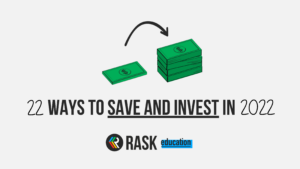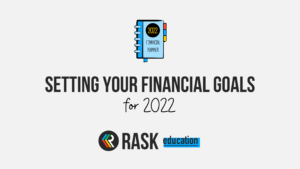This article explains what a risk profile is, the types of risk profiles for investors and how to determine your own investment risk profile.
One important aspect to consider when setting your financial plan is your attitude towards risk.
Understanding your own behaviour and emotions is a crucial part of investing, and even the best laid plans can come undone when your emotions and investments start mixing.
Over a lifetime of investing, if you apply yourself, your knowledge of investing will improve (which is good thing) and you’ll live through many market cycles (ups and downs).
There will be times when it seems like the world is going to ‘hell in a basket’, people will be losing their jobs and you’ll read a seemingly endless number of scary clickbait news headlines. Expect a market crash to happen every 5-7 years and you’ll be better prepared.
In order to stay calm and keep investing during a market crash, understanding your personal risk profile before building your investment plan and making investments is the most important first step.
What is a risk profile?
According to the CFA Institute, the term “risk profile” is often used, ‘as a blanket term to describe the various facts and investor traits that need to be taken into account to identify suitable investments for an investor’.
Your risk tolerance may also be regarded as your willingness and capacity to take risks with your money while taking into account your individual investment timeframe. For example, a 30-year-old full-time teacher (with a stable job) and 35 years before retirement will have a higher risk tolerance (and timeframe) than a casual worker at age 60.
Financial advisers in Australia often use the term “risk profile” to set the level of risk that you may be willing to take with your finances and determine the most appropriate financial products and investment strategies. For example, a financial adviser will might do a questionnaire and give say you’re a ‘conservative’ investor and offer an investment strategy that includes shares (riskier), bonds (less risky) and cash (least risky).
Financial companies will generally assign different risk profiles to their investment products to help retail investors differentiate between their investment options. You may have seen this before with your Super fund when you had to choose between Conservative, Balanced, Growth or Aggressive/high risk investment options.
Types of investor risk profiles
As an investor, you can manage the risks you take in accordance with your knowledge of investing, your risk profile and desired timeframe. Financial experts typically group investors into these main risk profiles:
- Conservative
- Balanced
- Growth
- High Growth
Risk profiles are not standardised so it’s important to recognise that not all “high growth” or “balanced” investments are the same.
For example, my personal high-growth share portfolio looks different to my Super fund’s high-growth portfolio, and my friend’s portfolio and Super are different again.
Take a look at some Aussie investing platforms like SixPark, Stockspot, InvestSMART and Raiz, and have a look at their asset allocations for each risk profile (see Owen’s explanations of allocations below).
Then compare your Super fund and a few other large Super funds’ investments, like AustralianSuper, Hostplus, REST, CBUS or Hesta. Ask yourself: how much of their ‘defensive’ or ‘high growth’ portfolios is invested in shares, bonds, cash or property?
This analysis will show you that the “typical” percentages given to each asset class (shares, property, etc.) under different risk profiles and time horizons, and may give you some guidance when working out your own approach.
Identifying your personal risk profile
Here are some example questions that a financial or robo adviser might ask you, to assist them in determining your risk profile:
- When do you plan to begin withdrawing money from your investments? The longer you have (e.g. 10+ years), typically the more risky investments you can make. The opposite is also true.
- How secure is your current and future income from sources like your salary and other investments? The more secure and high paying your job is, typically the more risk you can take. The opposite is also true.
- When considering your investments and making investment decisions, do you consider the impact of possible losses or gains? How would a 30% fall in ALL of your investments make your feel? If the thought of 20% falls from one year to the next scares you, you’re not a high growth investor.
- How much do you know about your money and investing? If you have taken our free online finance courses, listened to some good finance podcasts, and committed to learning, we believe you’ll be far better off in the long run because you’ll better understand the rewards and risks of investing.
- If you had an initial investment portfolio worth $50,000 and due to market conditions your portfolio fell to $40,000 within a short period, what would you do? If you would sell out completely, you’re not a high growth / high-risk investor. You might even consider using a financial adviser to do your investing.
You should keep in mind your life experiences are one of the major contributors to your financial risk profile. If you understand your investments, you’ll feel MUCH more comfortable during times of crisis.
Please don’t fool yourself. Judging your own risk profile is very tough to do. Even though you may believe you are a high-risk investor, you will not be able to truly test your reaction to a market crash until you go through a significant market correction.
How your investment timeframe impacts your risk profile
Something else to remember is that your risk profile will not always remain the same, and that’s perfectly normal. Different financial goals will have different timeframes, which may mean they fall into different risk brackets.
Let’s say for example that you’re saving up for a house over the next 3 years, that means you’ve got a short timeframe. So your capacity to take a risk with those funds is very low. Even though you might be in a high growth Super fund option, your risk profile for the house deposit should be Conservative (or just in a cash savings account).
For more information on managing your investment risk through diversification, tune into this episode of The Australian Finance Podcast.



